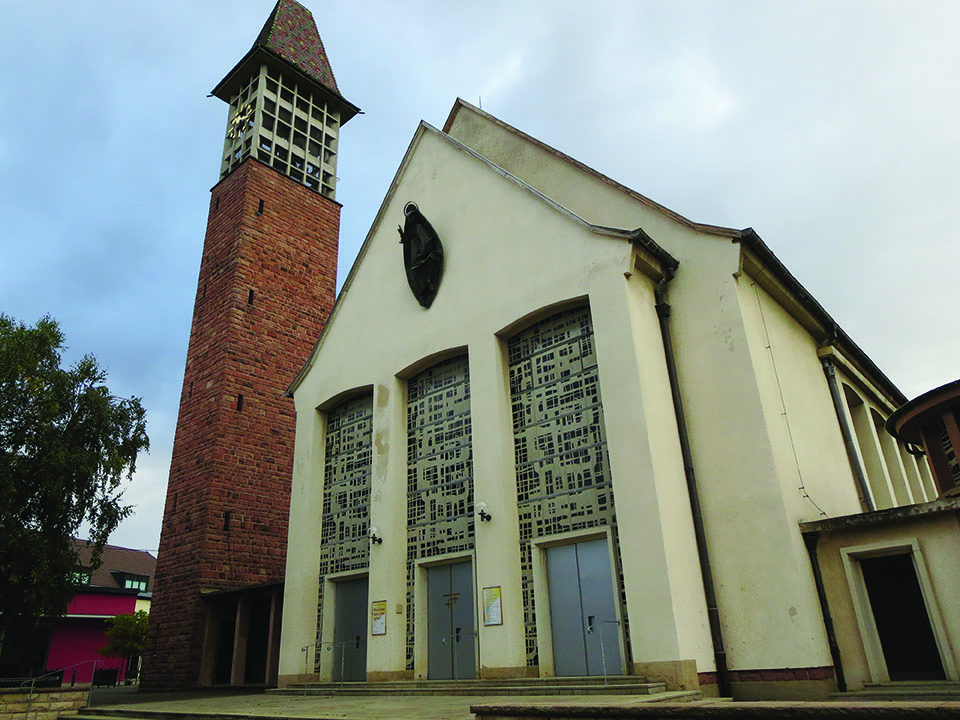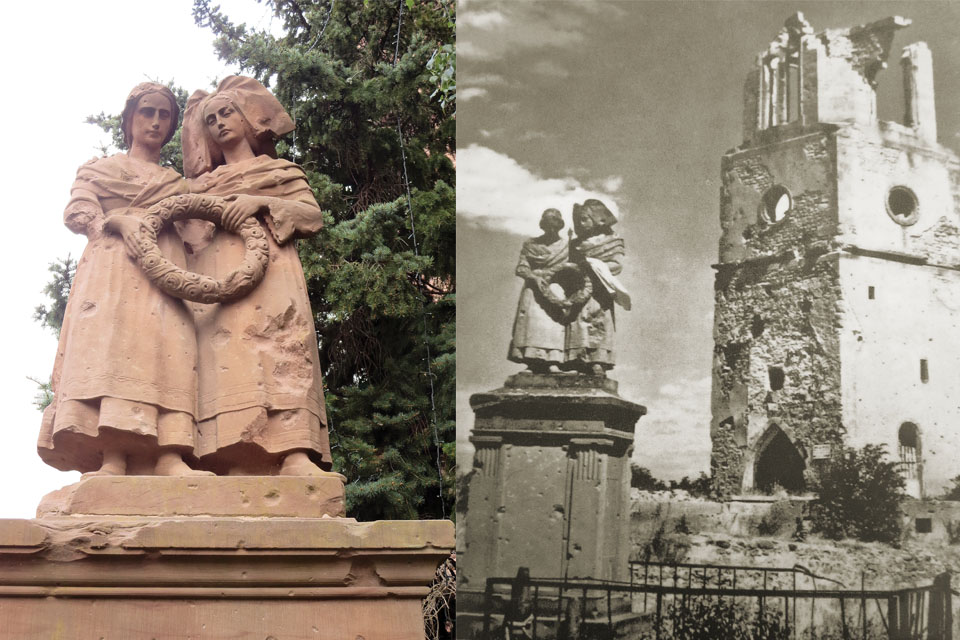VINEYARDS BLANKET THE STEEP HILLS that rise up on both sides of Route des Vins (Wine Road) in Alsace, France, as the lush Vosges Mountains loom in the distance. Here, tour busses compete for space with agricultural vehicles hauling boxes of plump grapes destined for world-renowned wineries. The road connects the region’s ancient villages, most of them crammed with colorfully painted half-timbered architecture, crooked lanes, and flocks of day-tripping tourists hemmed in by crumbling medieval walls.

Pulling off the main route, I pass a sign for Bennwihr, a town in the southeast region of Alsace. It’s immediately clear that Bennwihr is not like its adorable neighbors. Lining its streets are blocky, generic buildings that give off a look of modern suburbia rather than storybook France. The peaceful atmosphere is undisturbed by the noise of tourists, and no one is around but for the occasional farmer with a weather-beaten face. The quiet calm of Bennwihr is a welcome respite from the jostling crowds of the more popular surrounding villages, but there’s also the sense that something devastating happened here.
A nearby plaque is written in French but the accompanying photo gives me a clue: the grid-like street plan and sensible cement façades occupy the land where an older village once stood. At some point it was reduced to the smoldering ruins seen in the photograph. There’s a date I pick out within the French description: 1944.
In December 1944 German commanders decided upon an offensive in the Alsace Plain by the rugged Vosges Mountains of northeastern France, with the goal of smashing through the lines of the U.S. Seventh Army and the French First Army. The German attack was aggressive and devastating. The Allied forces bent, their two-pronged attack failing to push the German bridgehead west of the Rhine River and creating the so-called “Colmar Pocket” in the process. With the key city of Strasbourg in danger of enemy capture, a rattled General of the Army Dwight D. Eisenhower rushed troops and supplies southward to bolster the beleaguered lines.
The two sides fought tenaciously in the vineyards and heavily wooded mountains in frigid temperatures. Artillery and tanks tore at the landscape of the Alsace Plain, as troops battled frostbite and trench foot along with the enemy. House-to-house fighting raged in unfortunate towns that found themselves amid the crossfire. On the edge of the nearby hamlet of Holtzwihr, a young lieutenant of the U.S. 3rd Infantry Division named Audie L. Murphy was awarded the Medal of Honor for his actions on January 26, 1945, when he mounted a disabled tank destroyer, manned its .50 caliber machine gun, and singlehandedly staved off a German attack on his position.
Germans and Allies alike recognized Bennwihr’s strategic location at a crossroads, and its fate was sealed. German units hunkered down. Allied tanks, troops, and artillery entered the narrow town on December 22 and a battle commenced, obliterating Bennwihr’s medieval homes and historic church. Civilians huddled in wine cellars while infantry units exchanged fire in the streets above. Barrages of phosphorus shells set the remains of broken buildings ablaze. By the time the Allies secured the junction, plumes of black smoke rose from the ruins. Neighboring villages such as Mittelwihr and Sigolsheim were similarly pulverized.
The American and French armies held on despite the withering German assault. Having failed to cut U.S. supply lines or capture Strasbourg, the German offensive ended and the Battle of the Colmar Pocket concluded in Allied victory on February 9, 1945, with some 38,000 German casualties to the Allies’ 21,000.
Today the tanks and troops are gone. Hardworking Alsatian vintners create renowned wines here while holidaymakers flock to scenic nearby towns like Eguisheim, Riquewihr, and Kaysersberg, all tourist magnets. Bennwihr is the ugly sister scarred by misfortune, bypassed by the tour busses delivering visitors to more attractive members of the family. A workaday community, it subsists largely on agriculture.
It is October and the cool autumnal air carries the smell of burning wood. The gray skies and light drizzle add a note of mournfulness to the place. Strolling along the streets, I pass family-owned wineries that double as homes. Some houses contain newer elements integrated with older parts that survived the battle. A large, attractive winery built in the traditional Old-World style of the neighboring villages calls my name, and I drop in to sample a local wine. The highly regarded Marckrain Grand Cru, a light yellow vintage, is crisp, satisfying, and just a bit peppery.
Popping into a tiny grocery store, I notice there are no racks of overpriced postcards or tacky souvenirs. In fact, there are no souvenir shops around at all, unlike the nearby towns whose economies are sustained by tourism. It’s refreshingly authentic.
A bit further on, I stop at a small intersection on a residential street. An old well stands in a garden. A plaque beside it bears a wartime photo of the same well surrounded by the rubble of the former neighborhood, its residents already in the process of clearing the detritus. A description makes clear the well was the community’s source of clean water during the town’s postwar reconstruction. The image shows a scene common to war-torn communities: shattered homes, their remains being taken away by tired, shattered people.
Further down the main drag stands the village church. Like the rest of Bennwihr, it’s pleasant yet postwar practical. In my many travels throughout Europe, I am accustomed to entering churches and being immediately enveloped by the rich scent of incense lingering in the damp air. But Bennwihr’s church is clean and bright with an antiseptic modernity to it. The interior has carpet, not the typical flagstones. And the vibe is more spacious than spiritual.
Outside stands a weathered stone statue of two girls holding a wreath–one of the town’s few features to have survived the battle. The memorial, called “Fidélité” (faithfulness), was dedicated to the dead of the First World War, but the sorrowful figures could well be grieving over the second. A nearby plaque shows a grainy image of the church—a mutilated shell of a building lurking in the background as the silent stone figures stand near. The girls still bear gouges from shrapnel.

Heading out of town, I reflect on the toll inflicted upon villages like Bennwihr. There were thousands of such places during the war, innocent bystanders caught in the crossfire and destroyed. As Bennwihr recedes behind me, I look forward to visiting the more picturesque hamlets a few miles away and losing myself in their medieval ambiance. Those places feel more permanent. Although they, too, undoubtedly saw the horrors of past wars, those conflicts were more distant and less destructive. I remind my-self, however, that the resurrection of Bennwihr as a comfortable, prosperous community is an example of peoples’ resilience in the face of tragedy.
That is some comfort. ✯





